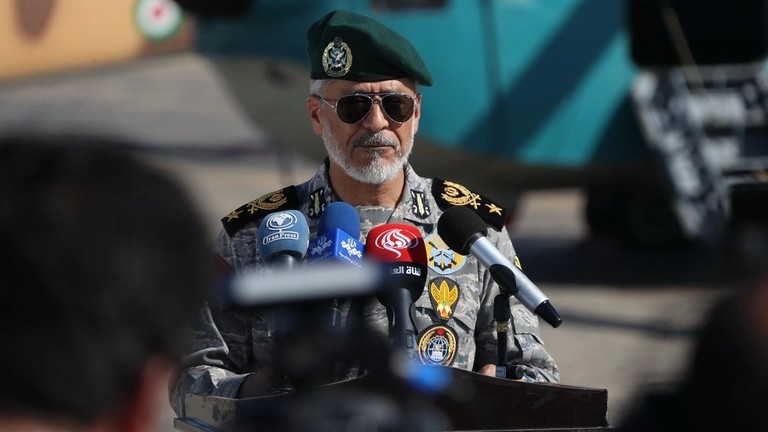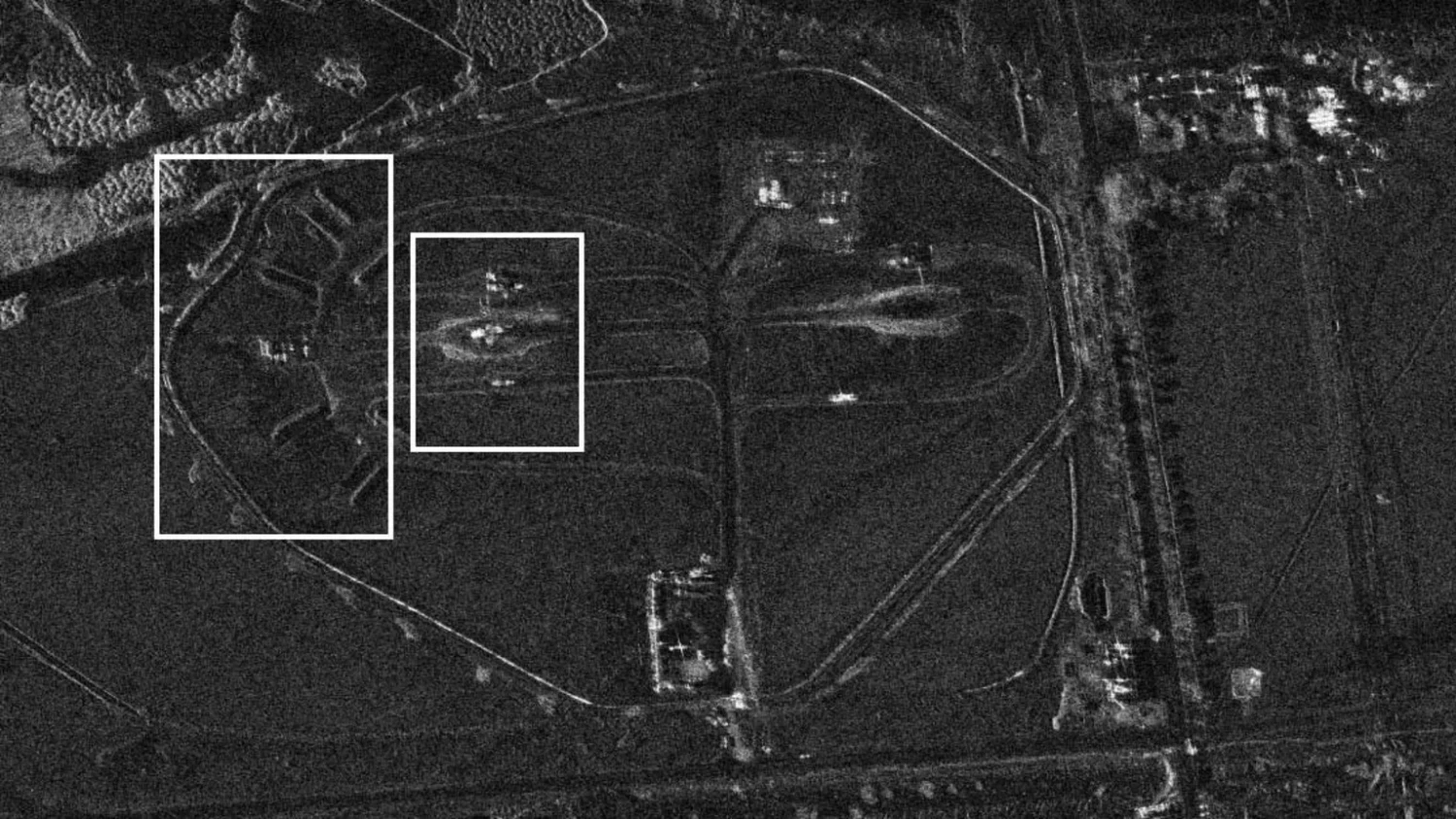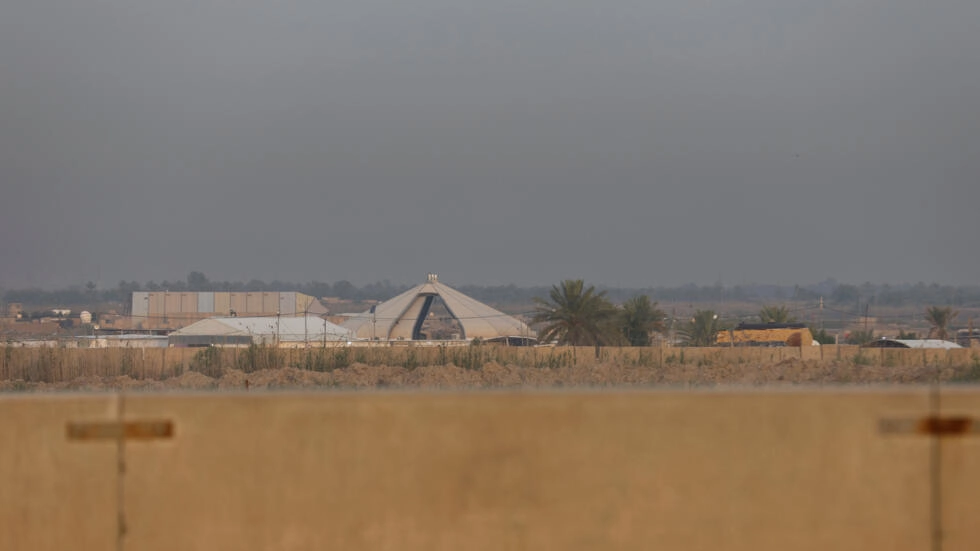Middle East
Military briefing: can the US and its allies stop the Houthis?
January 13, 2024 at 16:53
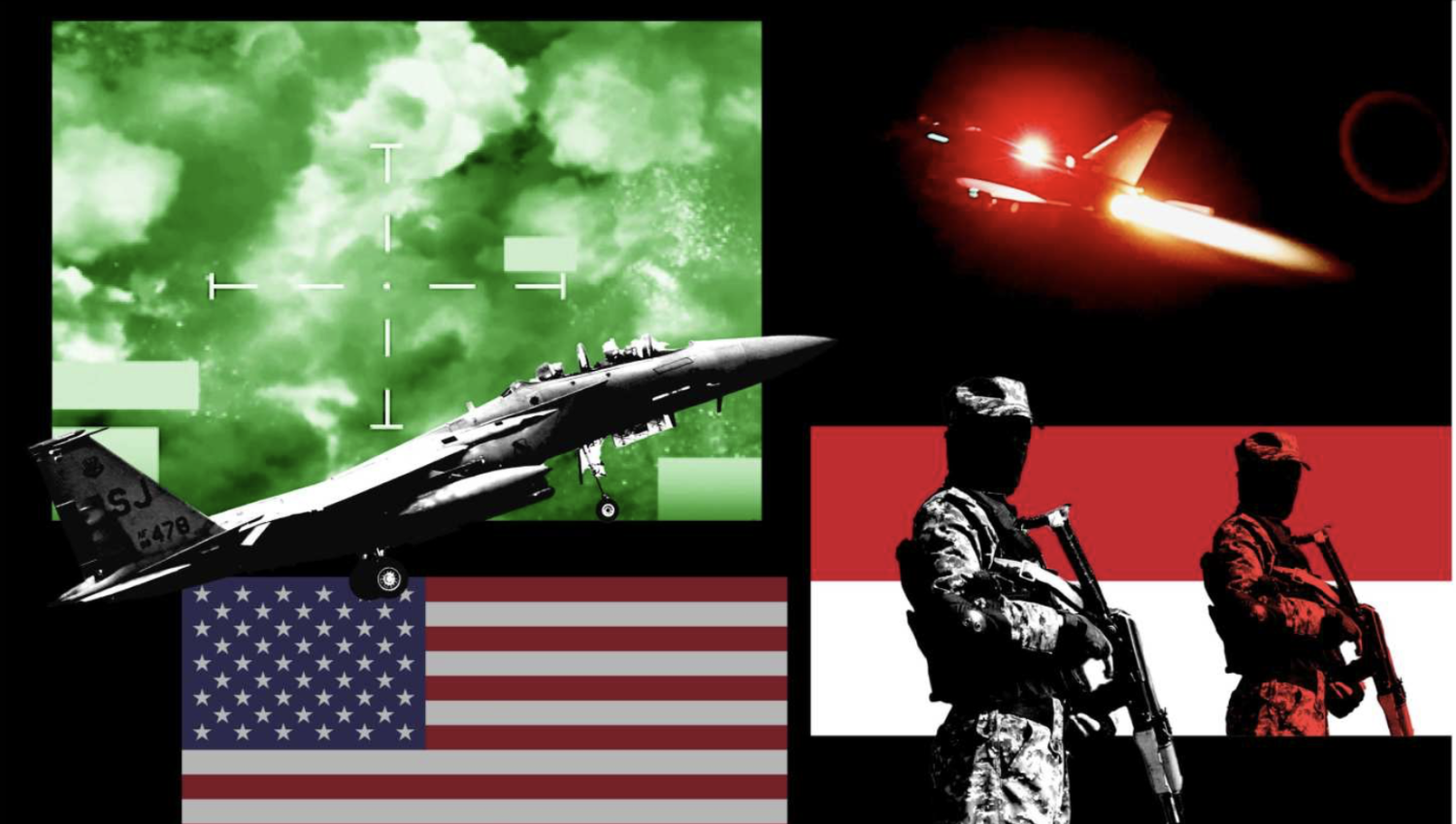
Joint American and UK attack sent a message but there are doubts whether battle-hardened Yemeni rebels can be cowed
The US and UK had for weeks warned of retribution against the Houthi rebels menacing a vital maritime trade route. Late on Thursday, under cover of darkness, their response arrived.
The US Navy fired dozens of Tomahawk cruise missiles towards Yemen from its destroyers and submarines around the Red Sea, while British jets launched laser-guided Paveway bombs at what the UK said were carefully selected targets. In the early hours of Saturday morning, the US launched a second bombing raid.
The strikes came after more than two dozen attacks were carried out by the Iran-backed group against commercial and military vessels in the Red Sea — a crucial global trade corridor now shunned by much of the world’s commercial shipping fleet — in response to Israel’s war against Hamas in Gaza.
The main questions now are whether this alone will stop the Houthis from continuing to attack shipping — and what might be the coalition’s response if the initiative fails. Many doubt whether the battle-hardened Islamists, who have weathered two decades of brutal fighting and almost 10 years of bombing by a Saudi-led coalition, will be cowed by the US and UK action.
“In many ways, there was no alternative to launching the strike: the Houthis couldn’t be allowed to continue until a major ship was hit. Inaction would have been worse,” said Peter Ricketts, former UK national security adviser.
“The calculation seems to have been to launch a big enough strike to change the Houthis’ behaviour, if not overnight, at least so that they slow down.”
There is a regional precedent for a big air strike altering behaviour. In 2018, the US, UK and France launched more than 100 aircraft and ship-based missiles against Syrian government sites in reprisal for chemical attacks against civilians in the country’s civil war.
The strikes did not end the fighting, but analysts said they did help to dampen it and reduce the frequency of chemical use.
The move against the Houthis was “similarly measured and calculated: careful around minimising risk of escalation but balanced with a lot of power to show intent”, said Sam Cranny-Evans, an associate fellow at the Royal United Services Institute in London.
Coalition forces in total fired 150 precision-guided munitions at more than 60 Houthi military installations and missile launch sites in the rebel-held north of the country. Civilian casualties, given the size of the missile strikes, were reportedly low. US military officials said they were still completing battle damage assessments.
“I don’t believe that they would be able to execute the same way they did the other day but we will see,” Lieutenant General Douglas Sims, director of the US Joint Staff, said in reference to a massive Houthi barrage this week.
So far, the public Houthi response has been defiant. On Friday, the group’s military spokesman General Yahya Saree said in a recorded address that the strikes, which he said had killed five people, would “not go unanswered or unpunished”.
In Saada, their stronghold in north-west Yemen, hundreds of people gathered for a rally on Friday to denounce the US and Israel, while thousands more gathered in a separate rally in the capital Sana'a.
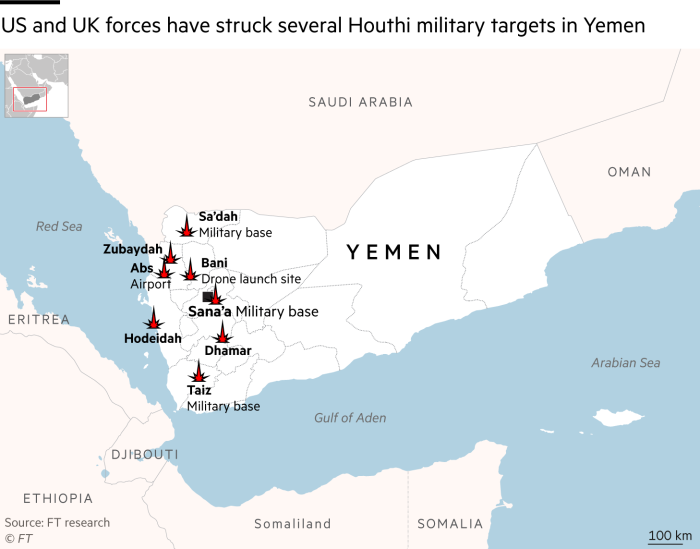
The militant group, which comes from Yemen’s rugged, mountainous northern Saada province, can muster about 35,000 uniformed troops, according to analysts.
Its capabilities were shown in a September military parade that featured a wide array of Iran-supplied ballistic and anti-ship missiles. Like Hamas, another member of the Iran-backed Axis of Resistance, it hides military assets and fighters in civilian areas.
Bilal Y Saab, an associate fellow at the Chatham House think-tank in London, questioned to what extent the coalition strikes would alter the rebel group’s behaviour.
“The Houthis have survived a Saudi-led Arab coalition bombing campaign for years. Limited attacks by the US and possibly its western allies, no matter how painful or surgical, will not crush [the] organisation,” he said.
“It’s incredibly hard to politically defeat or militarily destroy a deeply rooted, capable and resilient non-state actor such as the Houthis. It enjoys popular support, both domestically and regionally.”
The Houthis fought a nearly nine-year war against a Saudi-led coalition that intervened in Yemen’s civil conflict after the Houthis ousted the Yemeni government.
During that time, abetted by Iran, they have expanded their operations, graduating in just two years from launching unguided Katyusha rockets against targets 20 miles away in 2014 to launching medium-range ballistic missiles at Riyadh 600 miles away by 2016.
Even so, analysts stressed that the Houthis were not invulnerable. They lack advanced intelligence and surveillance tools to provide targeting information for long-range anti-ship systems, for which they largely rely on Iran.
They are sensitive about certain targets, such as their leaders, drone and missile storage sites, and irreplaceable helicopters and fixed-wing aircraft, Michael Knights of the Washington Institute for Near East Policy wrote in a recent report.
If the Houthis continue to attack Red Sea shipping and military vessels in the region, analysts said the hope among coalition partners was that continued surgical strikes combined with diplomatic efforts, especially with Iran, would help restore freedom of navigation.
On the diplomatic front, “the question is whether [Iran] has enough clout with the Houthis to stop them from launching more attacks against commercial shipping”, Saab said. “That remains an open question but Washington will never know until it tests that proposition.”
As for future military action, the US has a large numbers of Tomahawk land-attack missiles aboard its ships and submarines in the region, as well an aircraft carrier laden with jet fighters. The French frigate Languedoc, which has already shot down Houthi drones, carries land-attack missiles.
Yet the main UK warship in the Red Sea, the HMS Diamond, has no land-attack missiles. Any land strikes by British jets would therefore have to be carried out by Typhoon fighter jets flying thousands of miles from the RAF air base in Cyprus.
This, analysts said, would be of little use against the majority of Houthi rocket launchers that are highly mobile and could “shoot and scoot” into hiding long before British attack jets arrive.
Another factor potentially working in the Houthis’ favour is the cost to the coalition naval forces of sustaining their presence in the region.
“Both the US Navy and the UK Royal Navy will be hard-pressed to maintain their current commitment indefinitely and their ships are spread quite thin as it is,” said Nick Childs, senior fellow at the International Institute for Strategic Studies. “How long such a mission can be sustained will depend on how many other governments and navies are ready to take a meaningful share of the burden.”
Additional reporting by Felicia Schwartz in Washington
Copyright The Financial Times Limited 2024. All rights reserved.
The US Navy fired dozens of Tomahawk cruise missiles towards Yemen from its destroyers and submarines around the Red Sea, while British jets launched laser-guided Paveway bombs at what the UK said were carefully selected targets. In the early hours of Saturday morning, the US launched a second bombing raid.
The strikes came after more than two dozen attacks were carried out by the Iran-backed group against commercial and military vessels in the Red Sea — a crucial global trade corridor now shunned by much of the world’s commercial shipping fleet — in response to Israel’s war against Hamas in Gaza.
The main questions now are whether this alone will stop the Houthis from continuing to attack shipping — and what might be the coalition’s response if the initiative fails. Many doubt whether the battle-hardened Islamists, who have weathered two decades of brutal fighting and almost 10 years of bombing by a Saudi-led coalition, will be cowed by the US and UK action.
“In many ways, there was no alternative to launching the strike: the Houthis couldn’t be allowed to continue until a major ship was hit. Inaction would have been worse,” said Peter Ricketts, former UK national security adviser.
“The calculation seems to have been to launch a big enough strike to change the Houthis’ behaviour, if not overnight, at least so that they slow down.”
There is a regional precedent for a big air strike altering behaviour. In 2018, the US, UK and France launched more than 100 aircraft and ship-based missiles against Syrian government sites in reprisal for chemical attacks against civilians in the country’s civil war.
The strikes did not end the fighting, but analysts said they did help to dampen it and reduce the frequency of chemical use.
The move against the Houthis was “similarly measured and calculated: careful around minimising risk of escalation but balanced with a lot of power to show intent”, said Sam Cranny-Evans, an associate fellow at the Royal United Services Institute in London.
Coalition forces in total fired 150 precision-guided munitions at more than 60 Houthi military installations and missile launch sites in the rebel-held north of the country. Civilian casualties, given the size of the missile strikes, were reportedly low. US military officials said they were still completing battle damage assessments.
“I don’t believe that they would be able to execute the same way they did the other day but we will see,” Lieutenant General Douglas Sims, director of the US Joint Staff, said in reference to a massive Houthi barrage this week.
So far, the public Houthi response has been defiant. On Friday, the group’s military spokesman General Yahya Saree said in a recorded address that the strikes, which he said had killed five people, would “not go unanswered or unpunished”.
In Saada, their stronghold in north-west Yemen, hundreds of people gathered for a rally on Friday to denounce the US and Israel, while thousands more gathered in a separate rally in the capital Sana'a.

The militant group, which comes from Yemen’s rugged, mountainous northern Saada province, can muster about 35,000 uniformed troops, according to analysts.
Its capabilities were shown in a September military parade that featured a wide array of Iran-supplied ballistic and anti-ship missiles. Like Hamas, another member of the Iran-backed Axis of Resistance, it hides military assets and fighters in civilian areas.
Bilal Y Saab, an associate fellow at the Chatham House think-tank in London, questioned to what extent the coalition strikes would alter the rebel group’s behaviour.
“The Houthis have survived a Saudi-led Arab coalition bombing campaign for years. Limited attacks by the US and possibly its western allies, no matter how painful or surgical, will not crush [the] organisation,” he said.
“It’s incredibly hard to politically defeat or militarily destroy a deeply rooted, capable and resilient non-state actor such as the Houthis. It enjoys popular support, both domestically and regionally.”
The Houthis fought a nearly nine-year war against a Saudi-led coalition that intervened in Yemen’s civil conflict after the Houthis ousted the Yemeni government.
During that time, abetted by Iran, they have expanded their operations, graduating in just two years from launching unguided Katyusha rockets against targets 20 miles away in 2014 to launching medium-range ballistic missiles at Riyadh 600 miles away by 2016.
Even so, analysts stressed that the Houthis were not invulnerable. They lack advanced intelligence and surveillance tools to provide targeting information for long-range anti-ship systems, for which they largely rely on Iran.
They are sensitive about certain targets, such as their leaders, drone and missile storage sites, and irreplaceable helicopters and fixed-wing aircraft, Michael Knights of the Washington Institute for Near East Policy wrote in a recent report.
If the Houthis continue to attack Red Sea shipping and military vessels in the region, analysts said the hope among coalition partners was that continued surgical strikes combined with diplomatic efforts, especially with Iran, would help restore freedom of navigation.
On the diplomatic front, “the question is whether [Iran] has enough clout with the Houthis to stop them from launching more attacks against commercial shipping”, Saab said. “That remains an open question but Washington will never know until it tests that proposition.”
As for future military action, the US has a large numbers of Tomahawk land-attack missiles aboard its ships and submarines in the region, as well an aircraft carrier laden with jet fighters. The French frigate Languedoc, which has already shot down Houthi drones, carries land-attack missiles.
Yet the main UK warship in the Red Sea, the HMS Diamond, has no land-attack missiles. Any land strikes by British jets would therefore have to be carried out by Typhoon fighter jets flying thousands of miles from the RAF air base in Cyprus.
This, analysts said, would be of little use against the majority of Houthi rocket launchers that are highly mobile and could “shoot and scoot” into hiding long before British attack jets arrive.
Another factor potentially working in the Houthis’ favour is the cost to the coalition naval forces of sustaining their presence in the region.
“Both the US Navy and the UK Royal Navy will be hard-pressed to maintain their current commitment indefinitely and their ships are spread quite thin as it is,” said Nick Childs, senior fellow at the International Institute for Strategic Studies. “How long such a mission can be sustained will depend on how many other governments and navies are ready to take a meaningful share of the burden.”
Additional reporting by Felicia Schwartz in Washington
Copyright The Financial Times Limited 2024. All rights reserved.
Keywords
Newer articles
In case you missed it
<p>Chinese officials say they "firmly oppose" the platform being divested.</p>
Ukraine ‘will have a chance at victory’ with new US aid, Zelenskyy says
Congress passes bill that could ban TikTok after years of false starts
Ukraine war: Kyiv uses longer-range US missiles for first time
Who will be Trump’s VP? A shortlist
How soon could US ban TikTok after Congress approved bill?
‘LOSING CREDIBILITY’: Judge explodes at Trump lawyers as case heats up
TikTok faces US ban as bill set to be signed by Biden
KANYE WEST PLANS TO LAUNCH 'YEEZY PORN' ... Could Be Coming Soon!!!
Megan Thee Stallion’s Ex-Makeup Guru Talks. It’s Not Pretty.
